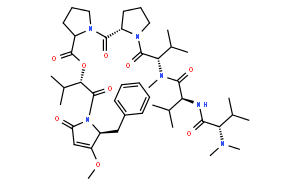| 中文名称: | Dolastatin 15 | ||||
|---|---|---|---|---|---|
| 英文名称: | Dolastatin 15 | ||||
| 别名: | DLS 15 | ||||
| CAS No: | 123884-00-4 | 分子式: | C45H68N6O9 | 分子量: | 837.06 |
| CAS No: | 123884-00-4 | ||||
| 分子式: | C45H68N6O9 | ||||
| 分子量: | 837.06 | ||||
基本信息
|
产品编号:D10696 |
|||||
|
产品名称:Dolastatin 15 |
|||||
|
CAS: |
123884-00-4 |
储存条件 |
粉末 |
-20℃ |
四年 |
|
分子式: |
溶于液体 |
-80℃ |
六个月 |
||
|
分子量: |
837.06 |
|
|
||
|
化学名: |
|
||||
|
Solubility (25°C) |
体外 |
DMSO |
|
||
|
Ethanol |
|
||||
|
Water |
|
||||
|
体内(现配现用) |
|
|
|||
|
<1mg/ml表示微溶或不溶。 |
|||||
|
普西唐提供的所有化合物浓度为内部测试所得,实际溶液度可能与公布值有所偏差,属于正常的批间细微差异现象。 |
|||||
|
请根据产品在不同溶剂中的溶解度选择合适的溶剂配制储备液;⼀旦配成溶液,请分装保存,避免反复冻融造成的产品失效。 |
|||||
生物活性
|
产品描述 |
一种从 Dolabella auricularia 中提取的去甲肽,是一种有效的抗有丝分裂剂,在结构上与抗微管蛋白剂 Dolastatin 10 有关。 |
|
靶点/IC50 |
Auristatin |
|
体外研究 |
Dolastatin 15 (DLS 15) induces cell cycle arrest at the G2/M phase followed by apoptosis in various human myeloma cell lines (RPMI8226, U266, and IM9). Dolastatin 15 induces apoptosis of myeloma cells via activation of both mitochondrial- and Fas (CD95)/Fas-L (CD95-L)-mediated pathways. Dolastatin 15 (DLS 15) displays growth inhibitory activity against all four SCLC cell lines (NCI-H69, NCI-H82, NCI-H345, NCI-H446) with IC50 values ranging from 0.039-28.8nM,which were 2.7-9.2-fold higher than the values for dolastatin 10. All four SCLC cell lines underwent G2/M arrest within 24 hours of exposure to dolastatin 15. |
|
体内研究 |
Dolastatin 15 conjugates to Trastuzumab via lysine residues at the drug C-terminus using a non-cleavable linker (Trastuzumab-amide-C-term-Dol15) produced target-dependent growth inhibition of cells endogenously expressing high HER2 levels (i.e., SK-BR-3, SK-OV-3) in vitro. This ADC was effective at varying doses (i.e.,10 and 20mg/kg) in the SK-OV-3 human ovarian cancer xenograft. |
本计算器可帮助您计算出特定溶液中溶质的质量、溶液浓度和体积之间的关系,公式为:
质量 (g) = 浓度 (mol/L) x 体积 (L) x 分子量 (g/mol)
摩尔浓度计算公式
用本工具协助配置特定浓度的溶液,使用的计算公式为:
开始浓度 x 开始体积 = 最终浓度 x 最终体积
稀释公式
稀释公式一般简略地表示为:C1V1 = C2V2 ( 输入 输出 )








